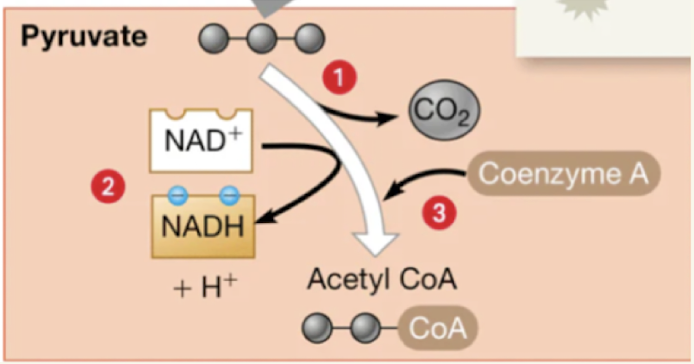Pyruvate Oxidation and Citric Acid Cycle
1/11
There's no tags or description
Looks like no tags are added yet.
Name | Mastery | Learn | Test | Matching | Spaced |
|---|
No study sessions yet.
12 Terms
what is Pyruvate Oxidation and overall goals
Pre-step in the CAC
Goal is to turn Pyruvate into Acetyl CoA
3 steps of pyruvate Oxidation
Pyruvate loses a carbon and two oxygens to form CO2
Resulting 2-carbon moelcule is then oxidized by giving electrons to NAD+ to make 2 NADH
Oxidized 2 -carbon moelcule is combined with a moelcules called Coenzyme A to produce Avetyl CoA

Citric acid cycle main goal
to continue dismantling pyruvate and harvest electrons from it
Where does the CAC occur
Matrix of mitochondria
Step 1 in citric acid cycle
To produce citrate
Acytyl CoA is stripped of CoA producing a 2 carbon molecule, this molecule is combined with a 4 carbon molecules called Oxaloacetate to produce citrate
Step 2 in the citric acid cycle
Citrate is formed into Aplha-Ketoglutarate
Citrate is oxidized resulting in the generation of NADH and CO2 to form Aplha-Ketoglutarate
Step 3 in the CAC
Aplha-Ketoglutarate if formed into succinate
CO2 is removed from Aplha-Ketoglutarate, Aplha-Ketoglutarate is further oxidized and ATP is produced by taking a phosphate out leaving Succinate to be formed
Step 4 of the CAC
Succinate is formed into Fumarate
Succinate is oxidezed by FAD (which turns into FADH2) and is transformed into Fumarate
Step 5 of the CAC
Fumarate is turned into Malate
H20 is added to fumarate and malate is formed
Step 6 of the CAC
Maltate is formed into Oxaloacetate
Maltate is oxidized by NADH and an etxra H+ is taken out to form Oxaloacetate (which enters the cycle again)
6 Transformations in the CAC
Oxaloacetate + (2 carbon thing)
Citrate
Aplha-Ketoglutarate
Succinate
Fumarate
Malate
Oxaloacetate
What is Oxidative Phosphorlaytion
ATP production
Electrons are loaded into NADH and FADH2 are carried to inner mitcondrial membrane to promote oxidative phosphorylation